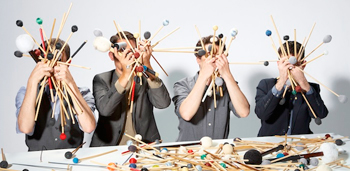by Daniel Hautzinger

Surrounded by paintings in Transformer Station’s gallery space, Sean Connors, Robert Dillon, Peter Martin, David Skidmore, and their setup of bells, marimbas, drums, bottles, and wood planks could have been an art exhibit themselves. The evening began in a more “traditional” percussion vein (whatever that means when a percussionist can be called on to play everything from a snare drum to a train whistle) with former Third Coast member Owen Clayton Condon’s Fractalia (2012). Numbering Steve Reich, electronica, and Taiko drumming among its influences, the piece is thrilling with oscillating marimba lines and bombastic drum solos, sounding almost like a song the progressive rock band Rush might have played in the 80s.
Reich himself was represented by Music for Pieces of Wood (1973). As its title suggests, the sole instruments are planks of hardwood. Simple rhythms interlock to form a catchy, clattering pulse. Alexandre Lunsqui’s Shi (2008) similarly used mundane objects as instruments. Lunsqui composed it while walking through New York’s Chinatown, banging on miscellaneous stuff with chopsticks. Thus, the performers trade in their mallets for chopsticks and rattle grill grates, whiskey bottles, glasses, and other sundries. Like kids let loose in a kitchen (or a bull in a china shop), Third Coast minus Martin grinned as they created an infectious racket.
The rest of the program moved beyond rhythm to percussion’s other capabilities. Thierry DeMey’s Table Music (1987) saw Connors, Martin, and Skidmore flourishing their hands in a mini ballet while clapping, tapping, and knocking on a table. It could have been one of those music videos where one bored-looking person suddenly sits up and begins poppy choreography, and soon everyone has joined in the fun.
Tobias Broström’s Twilight (2001) and the liquid encore, Peter Garland’s Apple Blossom (1972), showcased the beautiful rounded tones of the marimba with dark-hued chords and meditative textures.
Two movements of Augusta Read Thomas’s Resounding Earth, written for Third Coast, explore resonance through a variety of indigenous, ringing instruments. “Prayer,” the second movement, uses singing bowls that can be struck or rubbed to produce a multi-layered tone. The accumulation of many such sounds generated haunting, organ-like swells that felt tangible in their complexity. Gongs and spinning bells were clangorous and transporting in the third movement, “Mantra,” again melding overtones in rich waves of sound.
John Cage’s Third Construction (1941) received prime placement as the last piece on the program. The oldest work of the evening, Third Coast described it as one of the early masterpieces of percussion. Cage employs everything from a conch shell to coffee cans for a raucous bacchanal. Snippets of different global dance rhythms shuffle into the room, only to be swept up by the energetic joy of banging on things. What could be more fun?
Published on ClevelandClassical.com January 20, 2014
Click here for a printable version of this article.



